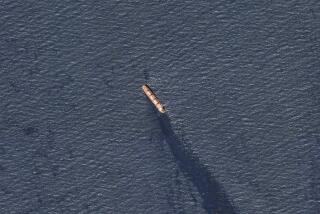Atlantic’s Vastness Dilutes Danger of Radiation
- Share via
The ocean can be very forgiving when it comes to environmental disasters, and its vastness may offer the greatest source of protection from any radioactivity from a Soviet nuclear submarine that sank in 18,000 feet of water in the Atlantic, several experts said Monday.
“There’s a lot of ocean there,” said Robert Norris of the Natural Resources Defense Council. “The safety problem is not a real one.”
Pentagon officials also said Monday there is no danger that any of the nuclear warheads aboard the Soviet vessel will explode. Other experts expressed confidence that what is yielded to the sea will stay there.
Some emphasized that the relatively small amount of radioactive materials, compared to the enormous amount of sea water, would minimize any danger from the submarine’s nuclear propulsion system or its 16 nuclear-tipped missiles.
“The dilution factor is the main thing,” said Tom Stefanick, an oceanographer with the Federation of American Scientists in Washington.
The fire and explosion that doomed the submarine occurred in one of the missile tubes, not the reactor area, according to the Pentagon, and experts believe the thick walls that surround the two reactors probably were not damaged.
In time, the shielding will corrode away, but Stefanick and others said that will be a very gradual process, so it will take many years for the radioactive materials to become exposed to sea water.
By then, much of the radioactive materials in the reactors will have decayed to harmless levels, according to D. John Gerig, president of Pickard, Lowe and Gerig, Inc., of Newport Beach. The firm specializes in risk analysis for nuclear plants.
The amount of radioactive material aboard the submarine is only a fraction of that released by the fire and explosion at the Chernobyl nuclear power plant in the Soviet Ukraine last spring. Gerig said the submarine’s power plant had only about a fifth as much radioactive material as Chernobyl, and the two accidents were very different.
“This was a fire (aboard the submarine) that was external to the reactor,” Gerig said. “In the case of Chernobyl, you had a graphite fire, and the graphite was an integral part of the reactor.”
The fire at Chernobyl carried radioactive materials into the atmosphere, but Gerig said the remains of the submarine, including its radioactive fuel, will most likely stay put on the bottom of the Atlantic.
More to Read
Sign up for Essential California
The most important California stories and recommendations in your inbox every morning.
You may occasionally receive promotional content from the Los Angeles Times.











